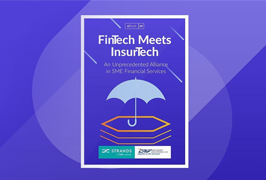London, 25 March 2021
London, 25 March 2021

The insurance landscape is quickly evolving due to the impact of COVID-19. Now more than ever, the insurance industry needs to reconnect and re-engage with its customers in a way that is truly relevant and adds value. The customer experience should be highly individual and business centric, encouraging the creation of a long-term partnership.
This extraordinary situation is affecting both the insurance consumer sentiment and buying habits, accelerating the need for digital and personalised cover. In my view, insurers should demonstrate more empathy and integrity by better communicating with their customers and investing in new innovative products to meet the current customer service demands. The pandemic experience has increased consumer propensity to interact and purchase services digitally. Today’s digital consumer expects a frictionless experience and complete convenience in all their transactions. Other sectors, like the retail industry, have already innovated to make this a reality.
Being a customer-centric insurer means making interactions with customers simple and time efficient with increased process automation, offering choice, adding real, personalised value, and demonstrating empathy. The nature of insurance products can equally be driven by evolving consumer needs. Typically, an insurance policy is less personalised than other financial products. The offerings are relatively standardised and often sold as packaged products. Considering the increased activity on insurance comparison websites and focus on savings, consumers are becoming more selective and only buying what they need, when they need it.
As customers increasingly embrace the digital marketplace, insurers and distributors risk losing their customer interface and becoming positioned as wholesale providers of a commoditised service. We are likely to see an uptake of usage-based insurance products, such as on-demand, pay-per-click or pay-per-use cover. Looking, for example, at new motor insurance policies, customers are often charged for the number of miles they drive rather than paying a fixed annual premium. In addition, new customers are emerging in this fast-changing environment, bringing new challenges for industry players. These include millennials and digital customers in general, who generally buy their products on Amazon in a single click or have started buying more online due to the lockdown restrictions. However, I strongly believe that digital acceleration will continue in the coming years and will persist even after this pandemic has ended.
Insurers will have to embrace innovation and emerging needs to rapidly design and go to market with new and relevant insurance products. New technologies are now available to allow insurers and distributors to rapidly trade new on-demand offerings and seize the growth opportunities of the post-COVID ‘new world’. Legacy systems can no longer be perceived as an obstacle to innovation and the evolving insurance landscape represents a significant opportunity.
Absolutely. Open data platforms enable an organisation to create a digital ecosystem and be part of a business ecosystem. A digital ecosystem is a group of interconnected information technology resources that can function as a unit. Digital ecosystems can be made up of suppliers, customers, trading partners, applications, and third-party data service providers. APIs enable ecosystem businesses to share their data and processes with other partners as part of their ecosystem.
Open platforms represent an opportunity for insurers to dynamically place the customer at the heart of their business, enabling them to reinforce their brand and reputation whilst operating efficiently and growing a profitable market share.
Those that have the foresight to embrace the challenge and the appetite to innovate to create propositions for today’s consumers and meet the requirements shaped by COVID-19 will undoubtedly reap the rewards.
 Would you like to learn more?
Would you like to learn more?Read our e-book FinTech Meets InsurTech: An Unprecedented Alliance in SME Financial Services